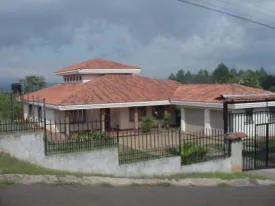Building a dream home in Costa Rica
Building a home in Costa Rica, or for that matter building anything here can be a daunting task.
To do the job properly requires a working (not tourist) knowledge of (contruction) Spanish or someone who can always be with you to translate.
Also you will need patience, time, patience, daily visits to the work site, patience, some knowledge of the building codes, patience, communications skills, and finally patience.
Just deciding where to live in Costa Rica should be one of your first priorities.
Quality of Construction in Costa Rica
In many countries, there are stiff building codes that must be adhered to by the contractor. That is simply not the case here and even if a code does exist, there is little or no enforcement.
Let’s discuss some of the little “surprises” you might encounter! These are very, very common things and not the exceptions!
- The vast majority of homes here have only 120v service to the home. Therefore, if you have large electric appliances like a dryer, you are screwed. Why is this? Probably because electricity is costly here and is treated more like a luxury than a necessity
- The 120v service that is installed is often low service, i.e. maybe 15 Amps for the whole house!
- The homes electrical system is almost NEVER earth grounded. Not only is this incredibly dangerous, but surge and noise filters will not work properly and many electronic items, PC’s, stereos, etc, can be at risk.
- Hot water may not be delivered to all faucets in all bathrooms. Again, as electricity is a luxury, so this is hot water in a guest bathroom! We have no hot water in the sink in our home! Ticos are happy to wash their hands in cold water.
- Goofy stuff like reversed water faucets. The word in Spanish for HOT is Caliente, so guess what the faucet marked C has flowing from it? Yup! Hot water. We also have this in our home and our guests sometimes wait a LONG time in the shower for the water to run hot!
- Outgoing waste piping can be the wrong diameter which can cause some very nasty happenings in your bathroom.
- The fixtures used may be of average or less quality. Here I speak of toilets and other necessities.
Some of this stuff is funny, like the cold faucet thing. Other stuff is just plain dangerous! I can go on and on, but choosing a home builder who builds to the standards you want is critical. This also of course includes the quality of the building materials. Make SURE your builder is cold stone fluent in your language and is also 100% fluent in construction and building Spanish. Also, make sure your builder, if not a Tico, is here in this country legally and has his Permanent Residency. No exceptions.
Communications is critical! Here is an example.

A friend of mine built a beautiful home just outside of San Josi a couple of years ago. A picture of his home appears at the left.
The problem was that he and his Tica (Costa Rican) wife were out of the country while the home was being built.
See that copula on the top of the house? Well THAT was the Tico version of a skylight! When they finally saw their new home… it was quite a surprise. Note that this was using a Tico company to build the home and the wife was Costa Rican! As most people will tell you, it is truly important that you be here in country to supervise construction.
Martin Rice, author of At Home in Costa Rica, has built two homes and has kindly submitted the following article which may be of help to those who plan to build their dream home in paradise.
Building Your Home in Costa Rica
© 2005 Martin Rice used with permission of the author
Lots of folks seem interested in building a house in Costa Rica. My wife and I have done this twice and thought that maybe knowing about some of our experiences might prove useful to others.
Because we’re focusing on building here, I won’t talk about buying land. I’ll assume that you’ve already acquired the land you want to use.
We arrived here with plans that we had purchased in the States. We found them in one of a myriad of home plan books that you can buy at bookstores. When we made our decision, we sent off for the the plans.
Although we loved the plans, we had to make a lot of necessary changes to make the construction suitable for Costa Rica. For example, we didn’t want the house built with wooden studs and sheet rock. We decided to use concrete block and stucco. There were other things, too. The plans showed a built-in vacuuming system. Not necessary; there was a heating and air-conditioning system. Definitely not necessary in our Costa Rica mountain home. Furthermore, we wanted a few design changes made.
Clearly we needed an architect to help us with all this. So we asked the realtors from whom we had bought the land if they could recommend one. They had someone they had worked with in the past and highly recommended. We had a close and quite friendly relationship with the realtors and we trusted them, so we followed their recommendation. After twice meeting with the architect, we asked him for a quote, found it reasonable, and contracted with him to make the modifications.
Of course we weren’t contracting with him to design the house from scratch by any means. Had we been doing that, the process would have been different. In any case, if you’re going to build a house, you must have some relationship with an architect so that the plans you submit for approval are properly stamped by a professional architect in good standing in Costa Rica.
You will also use the architect to obtain the building permits for you.
Make no mistake about it, you must get your building permits. I can’t tell you how many times I heard of people who had their building projects stopped dead in the water because they had no permits. The interesting thing is that after you’ve submitted your plans and received your permits, there’s not a lot of checking that goes on to make sure that what you’re building agrees with the plans. Personally, however, I would not take the chance of submitting plans that are not what you’re going to build.
Also in our agreement we contracted with him to be the supervising architect, that is he would submit the plans, as mentioned above, would do all the paper work, keep the on-site log required by law, work closely with the builder, etc. We paid him $10,000 for all of that. The funds were paid over the course of the project, according to an agreed-upon schedule.
We had already found a builder. He lived right in our little town. In fact, our property was part of a huge farm his father had once owned. He had built a lot of the houses for our neighbors, and we examined those very closely. We also looked very closely at houses in the neighborhood built by others. Our guy’s work was really superior, plus he had an excellent reputation with our friends and neighbors, almost all North Americans. We never regretted our decision to go with him.
When the architect had the plans ready, we gave them to the builder and two weeks later he came back with a price for all labor and materials. The price was more than we had expected. We now know that the reason for this was that he was concerned because the house was more complex than anything he had ever built before, and he was padding considerably to help ensure that he didn’t loose money. The fellow did everything on scraps of paper and didn’t have any kind of estimating system of any sophistication at all, he didn’t even have a computer. Some houses he made money on, on others he lost money.
Although the price was higher than we wanted, it was not unreasonable by any means. We both made some adjustments and soon agreed on a price. One thing should be stressed here, the price was for all labor and materials, that is, it was a fixed price. I’ll talk about alternatives later. It was agreed, of course, that any changes we wanted to make would cost extra. As it turned out, we did, indeed, make a handful of changes, one of which was significant and the others rather minor. But for each one we agreed beforehand on the cost so that we knew all along what the project was costing us.
Three things we talked about quite a bit before signing our agreement had to do with allowances, infrastructure improvements, and payment structure.
The question of allowances is extremely important in a deal such as this, that is, where there’s a fixed price. Clearly you the owner are going to select things like finishes (tiles, floors, counter tops, for example), paint, light fixtures, plumbing fixtures, doors, windows, cabinets, shelving, and many other things.
The builder has already estimated what these are going to cost him, otherwise he couldn’t give you a fixed price. So you have to know what he estimated so that when you pick things out you’ll know whether you’re right on the money, whether you’re going over budget, in which case you’ll owe the builder if you decide to purchase these thing anyway, or whether you’re under budget, in which case he will owe you money.
The question of infrastructure is important, too. One must make sure, for example, that the price includes bringing water to the property. In the rural areas where we built both times, there’s no such thing as “city water.” What about telephone lines to the property? What about electricity? All of this has to be planned beforehand, and there are costs here the builder isn’t responsible for.
For example, both times we built, although there was electricity available, there was no transformer on the road from which to supply our houses. So we had to pay the electric company for buying and installing a transformer. We had no phones where we first built, so there was no problem about installation. At our second house, telephone service was available, but the nearest pole was a kilometer away. We were responsible for paying for poles and cable and having the work done to bring the lines from that last pole to our house.
These things about electricity and phone might strike you as being strange or unusual. But if you live out in the country in Costa Rica, that’s the way it’s done.
Finally there was the question of payment. We worked out a schedule of how much we needed to give the builder and at what intervals. That made it easy for both of us to watch our cash flow.
Another important consideration while building is where you will be while the building is going on. The first time we built a large house, we were living in a small guest house right on the property and were always right there. Indeed, every day the foreman (who, by the way, was fantastic) would consult with us numerous times as did the subcontractors. Living on site is the absolutely best arrangement. It’s even better when, as in this case, the builder lives right in the neighborhood.
When we built the second house we were living in a rental house that was exactly a 20-minute drive from the building site. In addition, the architect/builder lived in San Josi. What a difference that made. We were obviously not always available to the foreman and subcontractors. We had to schedule regular meetings at exact times on certain days with the builder who had to travel about and hour and a half to get to the site. Although it was doable, it was far from ideal.
We have friends who continued to live in the States while their houses were being built. In most cases this resulted in large problems and great frustration.
All in all, the building of our first house went extremely well. The house itself was magnificent, we had all the input anyone could ask for and at the end of the day, we were still had a fine relationship with the builder.
I wish I could say that after the first experience, the second was even better because of all we had learned the first time. But the second time we did it differently and I must say that even though, in the end ,we were extremely pleased with the house, getting to that point was much more difficult than our first venture.
In this case, we didn’t start with pre-drawn plans, but we did have a highly detailed plan that my wife worked out with just a little bit of help from me. Then she built a model that would have done her proud in any school of architecture.
We met the builder by calling him after seeing his full-page ad in an upscale Costa Rican home and building publication. He was an extremely bright young man who only built log homes, which is what we wanted. There are other log home builders in Costa Rica and we investigated them all. But the type of homes they built were not what we were looking for.
What we did was to have a series of meetings with the architect at which we would present our ideas, he would make sketches, we’d come back, look at what he did, discuss it and then go to the next round. The purpose of this was to end up with a plan, on paper, with drawings (but not final blue prints) of what we would go ahead with. He charged us a set price for the series of meetings which was quite reasonable, less than $US1,000.
Eventually we agreed on a plan about which we were quite excited. At that point, we contracted, but on an entirely different basis than we did during the first project. This time there was a fixed cost for plans, labor and labor supervision. The idea here is that if they don’t meet the deadline for completion, we don’t pay anything extra regardless of how long they take.
The architect’s company was also the builder. Materials, however, were only estimated and we would pay for the materials as we went. In most cases they would buy the materials and I would pay the invoices directly to the vendors, unless the architect had already paid for them and gave me a cancelled invoice, in which case I would reimburse him.
All the things that are normally considered allowances, that is, the things the client picks, we ourselves would just pick and buy, since there was no set price for materials.
There are two potential dangers in doing this. The first is that the estimate made by the architect/builder is way off, in which case you could go way over budget on materials. The second is that the architect/builder could be in cahoots with the suppliers and we could be overcharged and they getting a “commission.”
The latter was not the case. I was convinced at the time that these were honest people and even after all the difficulties we later had, I still believe them to be honest men. But … that’s the only thing that went well.
So, we had the estimate for materials and a completion date 5 months out. They spent a great deal of time explaining to us why we could be sure that the estimated materials cost was right on the money and that the job was going to be on time. Unlike our first builder, these folks were highly computerized. Which just goes to show that the old saw about garbage in – garbage out as far as computers are concerned is absolutely right.
They were to start working on January 3rd or 4th and were to finish on May 30th. I fired all of them about early April because it was clear that at this point that they had no real idea of when the house was going to be done — I estimated that it was about 90% done.
At that point we were a good 20% over budget and I was having a hard time getting a fix on what was to come. As you can imagine, there was a lot of other stuff going on that contributed to my reaching the point of firing him. One significant problem was, as I mentioned, they were from San Josi and weren’t here nearly as often as they needed to be, and the foreman here was as bad as our first foreman was great. Additionally, they were always late on their estimates about when we, the clients, had to make certain materials choices. This in return resulted in either falling farther and farther behind schedule or our settling for something that wasn’t our first choice.
Eventually, after I fired them, the job was finished by a terrific local guy. Before we started the house, we had been the architect and supervisor for a large stable, a nice little house for our workers, a large gate, water system, etc. He had done a great job and, he’s extremely competent and, in general, an exceedingly nice and honorable young man. We didn’t consider him for the main house because we wanted someone with experience in building log homes. That was a mistake.
He did a fantastic job in getting the house and remaining infrastructure work done and had an extremely efficient crew of local workers. Man, what a difference between using local workers and workers who have no tie to the community.
Clearly, the first arrangement with a fixed price was far superior to this open-ended material purchasing arrangement. We’d certainly never go into an arrangement such as the second one again.
Concerning prices per sq. meter for building: there is a great, great range of prices so that it is difficult to speak generally. The variables involved are many. For example, a huge part of cost of materials is based on transportation charges. Thus, if you’re far away from the suppliers your materials cost can easily increase by as much as 30%. At times, I’ve had delivery charges that were 50% of the value of the materials delivered.
Labor costs, especially unskilled labor, vary from builder to builder, regardless of what the law says. This, too, tends to be influenced by location. If you’re building in a generally economically depressed area, the builder will pay the workers less than in an urban area where there might be more work available.
The type of house you’re building will make a great difference in per square meter cost as well. For example, the log and stone house of the second project required much more hand crafting than a block, concrete and stucco house, like the first one we built. But then comes design. The first one had many curved walls, niches, a curved stairway to the second floor, etc. All of this takes a lot more time to do and thus results in great labor charges.
In the second project, in addition to the house, we built a large stable, a small house for animal rehabilitation, a large flight cage for un-releasable bats we’ve rehabilitated, a small house for our workers, and a large storage facility. All the prices per sq. meter varied greatly, not only because of the usual variables but also because we used several different builders for the several projects.
But, just to give a general idea, a very good price for a simple home would be between US$270 per sq. meter (which is US$25 per sq. foot) to US$323 per sq. meter (US$30 per sq. foot). A simple house would be basically a one-story, rectangular structure with straight walls and a simple roof line built with block, concrete, and stucco. Some people refer to this type of design as a “Tico house.”
On the other hand, you should be able to build just about anything you want, regardless of how complex and complete, for between US$540 per sq. meter (US$50 per sq. foot) and US$645 per sq. meter (US$60 per sq. foot).
If you’re building a simple block and concrete house and you’re paying between US$40 per sq. foot and US$45 per sq. foot, you’re probably paying quite a bit too much.
And if you’re building anything for US$65 per sq. foot and above, you’re probably building a mini Taj Mahal.
Martin Rice
Puriscal, Costa Rica









